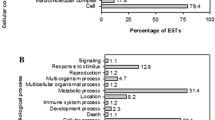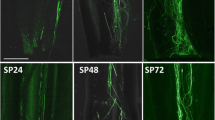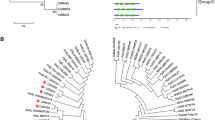Abstract
Self-incompatibility (SI) is one important factor that can result in Citrus seedlessness. However, the molecular mechanism of SI in Citrus is not clear yet. To isolate the pistil’s SI-related genes, a suppression subtractive hybridization library was constructed using mature pistils of ‘Wuzishatangju’ mandarin (SI) as the tester and mature pistils of ‘Shatangju’ mandarin (self-compatibility, SC) as the driver. 229 differentially expressed cDNA clones from 967 positive clones were sequenced and identified. Differentially expressed ESTs are possibly involved in the SI reaction of ‘Wuzishatangju’ through a regulating signaling pathway, serine/threonine phosphatase activity, receptor kinase, embryonic development, gibberellin stimulus, or transcription. 11 out of 36 SI candidate genes displayed different expression patterns in various tissues and stages after self- and cross-pollination of ‘Wuzishatangju’. The expression of CaBP (WY65), a senescence-protease (WY372), an unknown gene (WY283), and a WRKY (WY17) were up-regulated in the styles of ‘Wuzishatangju’ while higher expression of WY190 was observed in styles of ‘Shatangju’. Highest expression levels of WY65, WY372, an annexin (WY598), the zinc-finger protein (WY376), a C2-protein (WY291), and an unknown gene (WY318) were detected in styles at 3 days after self-pollination of ‘Wuzishatangju’ while lowest levels were observed in styles at 3 days after cross-pollination of ‘Wuzishatangju’ × ‘Shatangju’. The potential involvement of these genes in the SI reaction is discussed.





Similar content being viewed by others
References
de Nettancourt D (1997) Incompatibility in angiosperms. Sex Plant Reprod 10:185–199
Takayama S, Shimosato H, Shiba H, Funato M, Che FS, Watanabe M, Iwano M, Isogai A (2001) Direct ligand-receptor complex interaction controls Brassica self-incompatibility. Nature 413:534–538
Wang Y, Wang X, Skirpan AL, Kao T (2003) S-RNase-mediated self-incompatibility. J Exp Bot 54:115–122
Meng X, Sun P, Kao T (2011) S-RNase-based self-incompatibility in Petunia inflata. Ann Bot 108:637–646
Lai Z, Ma W, Han B, Liang L, Zhang Y, Hong G, Xue Y (2002) An F-box gene linked to the self-incompatibility (S) locus of Antirrhinum is expressed specifically in pollen and tapetum. Plant Mol Biol 50:29–42
Ushijima K, Sassa H, Dandekar AM, Gradziel TM, Tao R, Hirano H (2003) Structural and transcriptional analysis of the self-incompatibility locus of almond: identification of a pollen-expressed F-box gene with haplotype-specific polymorphism. Plant Cell 15:771–781
Sonneveld T, Tobutt KR, Vaughan SP, Robbins TP (2005) Loss of pollen-S function in two self-compatible selections of Prunus avium is associated with deletion/mutation of an S haplotype-specific F-box gene. Plant Cell 17:37–51
Sassa H, Kakui H, Miyamoto M, Suzuki Y, Hanada T, Ushijima K, Kusaba M, Hirano H, Koba T (2007) S Locus F-box Brothers: multiple and pollen-specific F-box genes with S haplotype-specific polymorphisms in apple and Japanese pear. Genetics 175:1869–1881
Wheeler MJ, Vatovec S, Franklin-Tong VE (2010) The pollen S-determinant in Papaver: comparisons with known plant receptors and protein ligand partners. J Exp Bot 61:2015–2025
McClure B, Mou B, Canevascini S, Bernatzky R (1999) A small asparagine-rich protein required for S-allele-specific pollen rejection in Nicotiana. Proc Natl Acad Sci USA 96:13548–13553
Goldraij A, Kondo K, Lee CB, Hancock CN, Sivaguru M, Vazquez-Santana S, Kim S, Phillips TE, Cruz-Garcia F, McClure B (2006) Compartmentalization of S-RNase and HT-B degradation in self-incompatible Nicotiana. Nature 439:805–810
Nathan Hancock C, Kent L, McClure BA (2005) The stylar 120 kDa glycoprotein is required for S-specific pollen rejection in Nicotiana. Plant J 43:716–723
McClure BA, Cruz-Garcia F, Beecher B, Sulaman W (2000) Factors affecting inter-and intra-specific pollen rejection in Nicotiana. Ann Bot 85:113–123
Yang B, Thorogood D, Armstead IP, Franklin FCH, Barth S (2009) Identification of genes expressed during the self-incompatibility response in perennial ryegrass (Lolium perenne L.). Plant Mol Biol 70:709–723
Distefano G, Caruso M, La Malfa S, Gentile A, Tribulato E (2009) Histological and molecular analysis of pollen-pistil interaction in clementine. Plant Cell Rep 281:439–1451
Chen X, Liu T, Hao S, Fang W, Wang Y, Li X (2011) Differential gene expression analysis of self-incompatible lines in tea by cDNA-AFLP. Afr J Biotechnol 10:10906–10913
Soost RK (1964) Self-incompatibility in Citrus grandis (Linn.) osbeck. Proc Am Soc Hortic Sci 84:137–140
Yamashita K (1978) Studies on self-incompatibility of Hyuganatsu, Citrus tamurana Hort. ex Tanaka. I. pollen behavior on stigmas and pollen tube growth in styles observed under a scanning electron microscope and a fluorescent microscope. J Jpn Soc Hortic Sci 47:188–194
Vardi A, Neumann H, Frydman-Shani A, Yaniv Y, Spiegel-Roy P (1998) Tentative model on the inheritance of juvenility, self-incompatibility and parthenocarpy. Acta Hortic 535:199–205
Yamamoto M, Kubo T, Tominaga S (2006) Self- and cross-incompatibility of various citrus accessions. J Jpn Soc Hortic Sci 75:372–378
Ye W, Qin Y, Ye Z, Teixeira da Silva JA, Zhang L, Wu X, Lin S, Hu G (2009) Seedless mechanism of a new mandarin cultivar ‘Wuzishatangju’ (Citrus reticulata Blanco). Plant Sci 177:19–27
Ngo BX, Wakana A, Kim JH, Mori T, Sakai K (2010) Estimation of self-incompatibility S genotypes of Citrus cultivars and plants based on controlled pollination with restricted number of pollen grains. J Fac Agric Kyushu U 55:67–72
Wang P, Lü L (2009) Self-incompatible reaction parts in Citrus grandis ‘Guanximiyou’ and ‘Duweimiyou’—observation of pollination on different pistil parts in vitro. Chin J Trop Crops 30:1105–1108
Roiz L, Goren R, Shoseyov O (1995) Stigmatic RNase in calamondin (Citrus reticulata var. austera × Fortunella sp.). Physiol Plant 94:585–590
Chai L, Ge X, Xu Q, Deng X (2011) CgSL 2 , an S-like RNase gene in ‘Zigui shatian’ pummelo (Citrus grandis Osbeck), is involved in ovary senescence. Mol Biol Rep 38:1–8
Miao H, Qin Y, Teixeira da Silva JA, Ye Z, Hu G (2011) Cloning and expression analysis of S-RNase homologous gene in Citrus reticulate Blanco cv. Wuzishatangju. Plant Sci 180:358–367
Chai L, Ge X, Manosh K, Deng X (2011) Molecular analysis and expression of a floral organ-relative F-box gene isolated from ‘Zigui Shatian’ pummelo (Citrus grandis Osbeck). Mol Biol Rep 38:4429–4436
Chai L, Manosh K, Ge X, Deng X (2010) Isolation, characterization, and expression analysis of an Skp1-like gene from ‘Shatian’ Pummelo (Citrus grandis Osbeck). Plant Mol Biol Rep 28:569–577
Caruso M, Merelo P, Distefano G, La Malfa S, Piero ARL, Tadeo FR, Talon M, Gentile A (2012) Comparative transcriptome analysis of stylar canal cells identifies novel candidate genes implicated in the self-incompatibility response of Citrus clementina. BMC Plant Bio. doi:10.1186/1471-2229-12-20
Miao H, Qin Y, Teixeira da Silva JA, Ye Z, Hu G (2011) Isolation and differential expression analysis of self-compatibility-related genes from mature pistils of ‘Shatangju’ mandarin (Citrus reticulata Blanco). J Hortic Sci Biotech 86:575–582
Luo M, Xiao Y, Hou L, Luo X, Li D, Pei Y (2003) Cloning and expression analysis of LIM-domain protein gene from cotton (Gossypium hirsutum L.). Acta Genet Sin 30:175–182
Livak KJ, Schmittgen TD (2001) Analysis of relative gene expression data using real-time quantitative PCR and the 2−ΔΔCT method. Methods 25:402–408
Franklin-Tong VE, Ride JP, Read ND, Trewavas AJ, Franklin FCH (1993) The self-incompatibility response in Papaver rhoeas is mediated by cytosolic free calcium. Plant J 4:163–177
Franklin-Tong VE, Holdaway-Clarke TL, Straatman KR, Kunkel JG, Hepler PK (2002) Involvement of extracellular calcium influx in the self-incompatibility response of Papaver rhoeas. Plant J 29:333–345
Wymer CL, Bibikova TN, Gilroy S (1997) Cytoplasmic free calcium distributions during the development of root hairs of Arabidopsis thaliana. Plant J 12:427–439
Roberts DM, Harmon AC (1992) Calcium-modulated proteins: targets of intracellular calcium signals in higher plants. Annu Rev Plant Physiol Mol Biol 43:375–414
Furuyama T, Dzelzkalns VA (1999) A novel calcium-binding protein is expressed in Brassica pistils and anthers late in flower development. Plant Mol Biol 39:729–737
Yang W, Lai Y, Li M, Xu W, Xue Y (2008) A novel C2-domain phospholipid-binding protein, OsPBP1, is required for pollen fertility in rice. Mol Plant 1:770–785
Rizo J, Südhof TC (1998) C2-domains, structure and function of a universal Ca2+-binding domain. J Biol Chem 273:15879–15882
Lee CB, Kim S, McClure B (2009) A pollen protein, NaPCCP, that binds pistil arabinogalactan proteins also binds phosphatidylinositol 3-phosphate and associates with the pollen tube endomembrane system. Plant Physiol 149:791–802
Smallwood MF, Gurr SJ, McPherson MJ, Roberts K (1992) The pattern of plant annexin gene expression. Biochem J 281:501–505
Carroll AD, Moyen C, Van Kesteren P, Tooke F, Batty NH, Brownlee C (1998) Ca2+, annexins, and GTP modulate exocytosis from maize root cap protoplasts. Plant Cell 10:1267–1276
Calvert CM, Gant SJ, Bowles DJ (1996) Tomato annexins p34 and p35 bind to F-actin and display nucleotide phosphodiesterase activity inhibited by phospholipid binding. Plant Cell 8:333–342
Fukuda H (2000) Programmed cell death of tracheary elements as a paradigm in plants. Plant Mol Biol 44:245–253
Thomas SG, Franklin-Tong VE (2004) Self-incompatibility triggers programmed cell death in Papaver pollen. Nature 429:305–309
Thomas SG, Huang S, Li S, Staiger CJ, Franklin-Tong VE (2006) Actin depolymerization is sufficient to induce programmed cell death in self-incompatible pollen. J Cell Biol 174:221–229
Jones ML, Chaffin GS, Eason JR, Clark DG (2005) Ethylene-sensitivity regulates proteolytic activity and cysteine protease gene expression in petunia corollas. J Exp Bot 56:2733–2744
Sugawara H, Shibuya K, Yoshioka T, Hashiba T, Satoh S (2002) Is a cysteine proteinase inhibitor involved in the regulation of petal wilting in senescing carnation (Dianthus caryophyllus L.) flowers? J Exp Bot 53:407–413
Chen G, Huang L, Yap MN, Lee RH, Huang Y, Cheng M, Chen S (2002) Molecular characterization of a senescence-associated gene encoding cysteine proteinase and its gene expression during leaf senescence in sweet potato. Plant Cell Physiol 43:984–991
Kong Z, Li M, Yang W, Xu W, Xue Y (2006) A novel nuclear-localized CCCH-type zinc finger protein, OsDOS, is involved in delaying leaf senescence in rice. Plant Physiol 141:1376–1388
Wassarman DA, Steitz JA (1992) Interactions of small nuclear RNA’s with precursor messenger RNA during in vitro splicing. Science 257:1918–1925
Jiang W, Yu D (2009) Arabidopsis WRKY2 transcription factor mediates seed germination and postgermination arrest of development by abscisic acid. BMC Plant Biol 9:96–110
Mesejo C, Martínez-Fuentes A, Reig C, Agustí M (2008) Gibberellic acid impairs fertilization in Clementine mandarin under cross-pollination conditions. Plant Sci 175:267–271
Dementhon K, Saupe SJ, Clavé C (2004) Characterization of IDI-4, a bZIP transcription factor inducing autophagy and cell death in the fungus Podospora anserina. Mol Microbiol 53:1625–1640
Acknowledgments
This work was supported by the National Natural Science Foundation of China (31000899), a Research Fund for the Doctoral Program of Higher Education of China (20104404120015 and 20114404110018), Guangdong Province Science Foundation of China (06025843), Science and Technology Planning Project of Guangzhou (2010r1-C771), and “211” Construction Fund for Key Subjects of College of Horticulture, South China Agricultural University.
Author information
Authors and Affiliations
Corresponding authors
Electronic supplementary material
Below is the link to the electronic supplementary material.
Rights and permissions
About this article
Cite this article
Miao, H., Qin, Y., da Silva, J.A.T. et al. Identification of differentially expressed genes in pistils from self-incompatible Citrus reticulata by suppression subtractive hybridization. Mol Biol Rep 40, 159–169 (2013). https://doi.org/10.1007/s11033-012-2045-6
Received:
Accepted:
Published:
Issue Date:
DOI: https://doi.org/10.1007/s11033-012-2045-6




